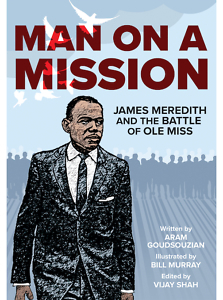Drawn into Conflict
Aram Goudsouzian talks with Chapter 16 about a new graphic history on James Meredith
Sixty years ago this September, after battles in the courtroom and on the streets of Oxford, Mississippi, James Meredith became the first Black student successfully enrolled in Ole Miss. His fight was just beginning. As Aram Goudsouzian acknowledges in the preface for Man on a Mission: James Meredith and the Battle of Ole Miss, this heroic story has been told before, most notably in Meredith’s own 1966 memoir, Three Years in Mississippi. But until now, it has never appeared in graphic novel form.
 Much as the late congressman John Lewis did with his groundbreaking March trilogy, Meredith hoped to bring his life to a younger audience. As author of the comprehensive 2016 book Down to the Crossroads: Civil Rights, Black Power, and the Meredith March Against Fear, Goudsouzian — a history professor at the University of Memphis — was an ideal choice to shepherd the tale into graphic form. Working with editorial cartoonist Bill Murray and editor Vijay Shah, he’s written a powerful narrative in pages that visually capture the gritty, dangerous feel of the Deep South at the height of the civil rights movement. He recently answered questions via email about the project.
Much as the late congressman John Lewis did with his groundbreaking March trilogy, Meredith hoped to bring his life to a younger audience. As author of the comprehensive 2016 book Down to the Crossroads: Civil Rights, Black Power, and the Meredith March Against Fear, Goudsouzian — a history professor at the University of Memphis — was an ideal choice to shepherd the tale into graphic form. Working with editorial cartoonist Bill Murray and editor Vijay Shah, he’s written a powerful narrative in pages that visually capture the gritty, dangerous feel of the Deep South at the height of the civil rights movement. He recently answered questions via email about the project.
Chapter 16: How did the idea for this book come about?
Aram Goudsouzian: My own interest in James Meredith’s story began over a decade ago, when I was writing Down to the Crossroads, a history of the Meredith March Against Fear in June 1966. That mass march was a huge national event that is famous for unleashing the slogan “Black Power,” but it began as a quixotic, more or less solo walk by Meredith, who was shot and wounded on the second day of his trek. I grew fascinated by Meredith — he is quirky, fearless, inscrutable, heroic, frustrating, a consummate individualist who sometimes manages to summon the power of mass movements and national institutions.
More recently, the University Press of Mississippi reissued Meredith’s original memoir from the 1960s, Three Years in Mississippi, which details his experience integrating the University of Mississippi. I wrote the introduction to the reprinted memoir. Vijay Shah, who at that time was an editor at the press, asked me about my interest in collaborating on a graphic history of Meredith. He had lined up a veteran illustrator, Bill Murray. It sounded intriguing, so I agreed to join the team.
Chapter 16: You normally write traditional histories. How did you distill James Meredith’s complex story into short visual scenes for a graphic work?
 Goudsouzian: It was tough! My longtime experience is in using words to tell stories and paint scenes, and the graphic format demands that pictures do much of that work. So, as I outlined the story of Meredith’s life with a focus on the “Battle of Ole Miss,” I kept researching visual evidence, thinking about how images could help drive his narrative. Then, as Bill started drawing pages, I better understood his style and his strengths, and I began tailoring pages along the lines of what he does best.
Goudsouzian: It was tough! My longtime experience is in using words to tell stories and paint scenes, and the graphic format demands that pictures do much of that work. So, as I outlined the story of Meredith’s life with a focus on the “Battle of Ole Miss,” I kept researching visual evidence, thinking about how images could help drive his narrative. Then, as Bill started drawing pages, I better understood his style and his strengths, and I began tailoring pages along the lines of what he does best.
Chapter 16: What was it like to develop a story with an 89-year-old civil rights icon known for strong opinions on just about everything?
Goudsouzian: We had Mr. Meredith’s support from the beginning. He wanted his story told for the younger generations, and he trusted us to do it.
He is a man who follows his own path. He decided to apply to Ole Miss, and the civil rights movement and the federal government had to catch up. He decided to walk through Mississippi, and after his shooting an enormous civil rights march had to follow. He has also made bizarre pronouncements about his divine destiny, questionable choices in business and politics, needless criticisms of other Black activists, and objectionable alliances with far-right conservatives such as Jesse Helms and David Duke. He does not fit into any conventional box as a civil rights icon.
For Man on a Mission, we sought to capture Meredith’s unique outlook by telling the story in his voice. He is the narrator of the book. The main source is Three Years in Mississippi, though we complement the memoir with other first-person accounts from Meredith, as well as histories of the Ole Miss crisis.
Chapter 16: Many visual panels appear based on photographs. How did you find and choose them?
Goudsouzian: One of Bill’s gifts as an illustrator is his ability to artistically integrate and modify photographic sources, while adding all sorts of trademark visual flourishes. His talents give the book its distinctive look. While writing the script for each page, I would try to not only describe a scene, but also provide Bill with photographs to consider for visual inspiration. I especially relied on the online collection of photographs made available through the Department of Archives and Special Collections at the University of Mississippi.
Chapter 16: The book includes a set of discussion questions. What do you hope students and younger readers take away from events that began over 60 years ago?
Goudsouzian: Like any historian of the era, we hope that our readers understand the depths of white resistance to racial integration in the 1960s, the courage of Black activists in confronting white supremacy, and the central place of the civil rights movement in the history of our nation’s democracy. By focusing on Meredith, though, we also hope that readers appreciate this brave and unconventional figure. He illustrates the power of an individual to shape history, as well as the limits on that power.
Chapter 16: Do you plan to write more graphic histories? If so, what’s next?
Goudsouzian: To use a sports term, I think I am “one and done” on graphic histories. I thought it would be a short, fun departure from my typical writing pursuits. Instead, it involved a drawn-out process, various frustrations and spats, and way, way, way too many emails. But Bill, Vijay, and I are all proud of the book. Mr. Meredith loves it, too. All of us are thrilled that we brought his story to a new generation.

Michael Ray Taylor is the author of Hidden Nature and other books. He lives in Arkansas, where he is currently working on a novel.




